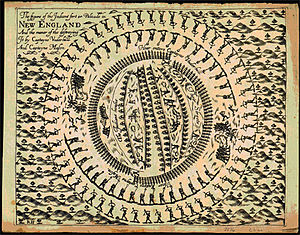- Mystic massacre
-
The Mystic massacre took place on May 26, 1637, during the Pequot War, when English settlers under Captain John Mason, and Narragansett and Mohegan allies set fire to a fortified Pequot village near the Mystic River. They shot any people who tried to escape the wooden palisade fortress and killed the entire village, consisting mostly of women and children, in retaliation for previous Pequot attacks.[1] The only Pequot survivors were warriors who had been with their sachem Sassacus in a raiding party outside the village.
Contents
Background
The Pequot were the dominant Native American tribe in central to eastern Connecticut and had long competed with the neighboring Mohegan and Narragansett.[2]:167 When the English and Dutch arrived, they established trade policies, trading such things as wampum for European goods. The Pequot eventually allied with the Dutch, while the Mohegan and others allied with the British. European population growth led to greater land theft, leading to eventual conflict with indigenous populations. A series of Eurasian infectious diseases, such as smallpox, to which the Native Americans had no immunity, drastically reduced the Pequot population, tipping the population balance in high favor of the settlers.[2]:174
When a trader named John Oldham was killed and his trading ship looted by natives suspected to be Pequot,[2]:177 retaliation raids by settlers and their native allies ensued, and Pequots responded in kind, erupting into the Pequot War.
The massacre
The Connecticut towns raised a militia commanded by Captain John Mason consisting of 90 men, plus 70 Mohegan under sachems Uncas and Wequash. Twenty more men under Captain John Underhill joined him at Fort Saybrook.
The Pequot sachem Sassacus, meanwhile, gathered a few hundred warriors and set out to make another raid on Hartford, Connecticut.
At the same time, Captain Mason recruited more than 200 Narragansett and Niantic warriors to join his attack force. On the night of May 26, 1637, the forces of English and Native American attackers arrived outside the palisade-surrounded Pequot village near the Mystic River, which had only two entrances/exits. The English attempted to attack the villagers by surprise, yet met with stiff Pequot resistance. Mason gave the order to set the village on fire and block off the exits. The Pequot were trapped inside. Those who tried climbing over the palisade were shot; anyone who succeeded in getting over was killed by the Narrangasett forces.[2]:190–93
Aftermath
Estimates of dead Pequot range from 400 to 700, mostly women and children and old men, as the warriors were out on a raiding party. On top of their being weakened from disease, the massacre practically broke the Pequots, who fled and were hunted down. Sassacus and many of his followers were surrounded in a swamp near a Mattabesic village called Sasqua. In the following battle, Sassacus and about 80 others managed to escape. Nearly 180 warriors were killed, wounded, or captured. Sassacus was eventually killed by the Mohawk, who sent his scalp to the English as a symbol of friendship.[2]:196
The war ended with the signing of the Treaty of Hartford on September 21, 1638. The English sold captured Pequot as slaves or servants and took their lands. The Pequot numbers were so diminished that they ceased to be a tribe in most senses. The treaty even mandated that the remaining Pequot were to be absorbed into the Mohegan and Narragansett tribes, nor were they even allowed to refer to themselves as Pequot.[2]:196 In the later 20th century, Pequot descendants revived the tribe, achieving federal recognition and settlement of some land claims.
The massacre was featured in the History Channel series 10 Days that Unexpectedly Changed America.
See also
References
- ^ The Society of Colonial Wars: 1637 - The Pequot War.
- ^ a b c d e f Vowell, Sarah (2008). The Wordy Shipmates. Riverhead Books. ISBN 978-1-59448-999-0.
Further reading
- Cave, Alfred A. "Who Killed John Stone? A Note on the Origins of the Pequot War", The William and Mary Quarterly, 3rd Ser., Vol.49, No.3 (Jul. 1992), pp. 509–521
Categories:- 1637 in the Thirteen Colonies
- Massacres in the Thirteen Colonies
- Massacres of Native Americans
- Mystic, Connecticut
- Groton, Connecticut
- New London County, Connecticut
- Pre-state history of Connecticut
- Military history of the Thirteen Colonies
Wikimedia Foundation. 2010.

